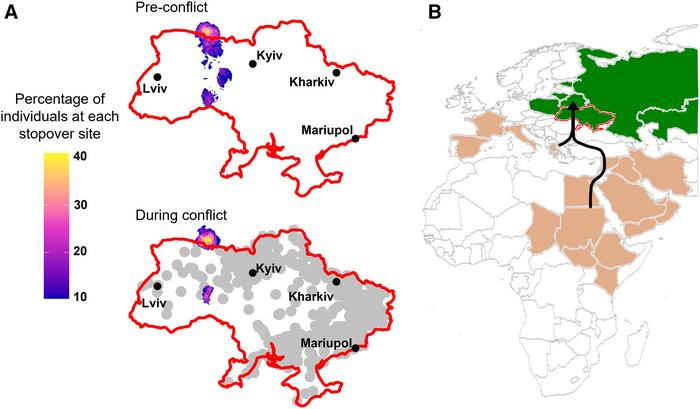A new study has found that Greater Spotted Eagles, a vulnerable raptor species, significantly altered their migratory behavior when passing through Ukraine during the 2022 Russian invasion. The research, published in the journal Current Biology, provides rare quantitative evidence of how human conflicts can impact animal behavior far beyond the immediate conflict zone.
The study tracked 21 Greater Spotted Eagles fitted with GPS tags as they migrated from their stronghold breeding grounds in Belarusian Polesia. The researchers, from the Estonian University of Life Sciences, British Trust for Ornithology (BTO), and local partners, originally aimed to identify key areas the eagles rely on to inform conservation efforts. However, the eagles’ migration in March 2022 coincided with the spread of the Russian invasion across Ukraine.
Eagles Made Large Detours and Spent Less Time at Stopovers
Comparing the eagles’ 2022 migration to data from previous peaceful years, the researchers found significant behavioral changes. The birds made substantial deviations from their usual routes to avoid conflict hotspots. They also spent less time at crucial stopover sites used for refueling during their long journeys.
“Armed conflicts can have wide-ranging impacts on the environment, including changes in animal behavior,” said Charlie Russell of the University of East Anglia, UK, in a press statement. “Our study provides the first quantitative evidence of this, showing how migrating eagles made deviations to avoid conflict events and spent less time refueling at stopover sites.”
Conflict-Induced Changes Could Have Lasting Impacts
The researchers noted that the changes to the eagles’ migratory patterns delayed their arrival at breeding grounds and likely increased energy expenditure, which could detrimentally affect the birds. While all tagged eagles survived, the experience may have lingering impacts into the breeding season and beyond.
“Similar responses have been recorded for birds residing in military training zones, but these new findings that show an impact for migratory species means that disturbance events can have more far-reaching impacts across many more individuals, over greater distances,” said Adham Ashton-Butt of BTO.
The findings underscore the far-reaching environmental consequences of armed conflicts, stretching well beyond the immediate humanitarian crisis. The researchers emphasize the need to consider impacts on species and ecosystems during post-conflict recovery efforts. The study also raises questions about how the Ukraine conflict and other extreme human-caused disturbances may affect a wide range of species, including threatened species and millions of migratory birds.


